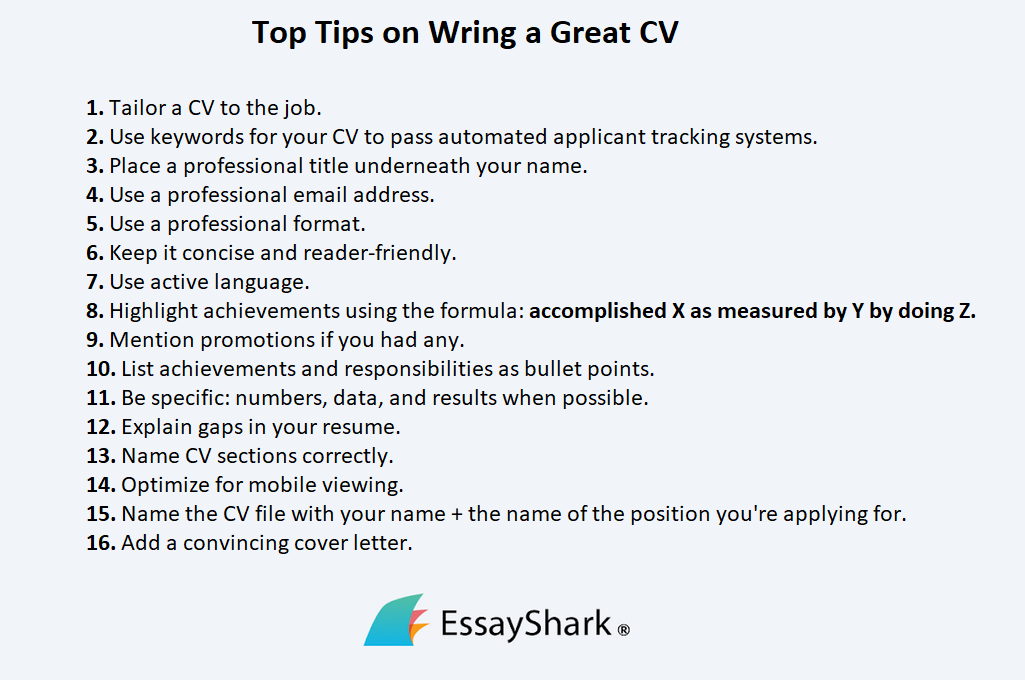In today’s article, you’ll learn how to write a CV according to the latest trends and expert tips.
In fact:
These are the same strategies that help job seekers, including those with little to no work experience, hook recruiters and land a dream job.
Ready to dive right in? Here we go.
Table of contents
How to Write a CV: The Basics
A CV (curriculum vitae) is a summary of your skills, experience, and qualifications for a potential employer to see why you’re a great candidate for them. HRs get tens of CVs for each vacancy, so it’s critical to write a CV that stands out, motivating recruiters to invite you for an interview.
Why do you need a stellar CV?
- Outline your skills and experience
- Catch an employer’s attention
- Highlight your value
- Show them you’re the right person for the job
- Land an interview
What do you include in your CV?
Must-have elements: your name, contact details, previous work experience, qualifications, education, and most relevant skills
Optional yet not superfluous: your social media accounts (a professionally looking LinkedIn profile, for example), personal statement, awards (if you have any relevant to the position you are applying for), and hobbies or interests

Important:
Most articles on CV writing and websites that provide customizable templates for designing this document use the word “resume” when discussing CVs. We do the same here, as it’s relevant for job seekers in most fields except academia.
And yet, these two documents are slightly different. The comparison table below will help you understand that difference and organize your CV (or resume) accordingly:
| CV (curriculum vitae or “course of life”) | Resume (“abstract” or “summary”) |
| A detailed document highlighting your professional and academic path | A formal document overviewing your professional background and skills |
| Emphasis: academic credentials | Emphasis: experience and skills |
| Starts with the education section | The education section goes at the bottom (after skills and experience) |
| One core format | Different formats: reverse chronological, creative, functional, combined |
| 2-3 pages, may include appendixes (check what is an appendix in writing) | 1 page |
| Write when applying for positions in academia (science, research, education, grants) | Write when applying for non-academic jobs |
Designing Your CV: Layout and Format
With so many ready-made and customizable resume templates available online, you won’t find it super challenging to craft an eye-pleasing CV. You just need to pick the proper format and fix up your resume layout to look organized, attention-grabbing, and reader-friendly.
The three core types of resume formats are as follows:
- Reverse-chronological: You list your most recent work experience and qualifications first.
- Functional: You focus more on skills than work experience. (Perfect for recent graduates or applicants with little or no background in the field.)
- Combined: It’s a mix of two when you place equal emphasis on skills and work experience. (Perfect for savvy job-seekers with a diverse skill set applying for a role requiring expertise in different fields.)
In 99% of cases, recruiters expect to see a reverse-chronological resume. Here’s a standard template you can use:

Once you pick the format and a corresponding layout for your resume, customize it to determine its overall look. Keep it simple: Overplaying with creative elements like colors, fancy fonts, and images can do more harm than good. Stick with clear section titles, a one or two-column format, and an easy-to-read font.
General rules to follow when designing your resume layout:
| Length | One page |
| Font | Roboto, Overpass, Ubuntu (no Comic Sans, please!) |
| Line spacing | 1.0 or 1.15 |
| Bullet points | Up to 6-10 in each section |
| Format | |
| Extra | White space around the margins; a consistent design — margins, fonts, spacing, colors — throughout the whole document |
How to Write a CV With No Work Experience
That’s the paradox most college graduates have to face: You need experience to get a job, but you need a job to get that experience.
What to do?
What can you offer potential employers if you’re an only recently graduated student just entering the job market?
What should you include in your CV if you don’t (yet!) have any significant achievements or career roles under your belt?
Look:
A lack of work experience doesn’t mean a lack of potential. Luckily, most employers look beyond the world of work when reviewing and interviewing candidates. You gained enough skills and achievements during your college years, and what you should do now is find creative ways of showcasing them.
Keep reading to learn what you can include in your CV besides work experience.
| Extra read! You can’t miss our ultimate guide on how to write a diagnostic essay: Learn how to craft texts so that the audience positively assesses your skills. |
Add a personal statement
Place it at the top of your resume so that it’s the first thing recruiters see. Important: Keep it short and simple, up to 150 words maximum! Remember that no one has time to read your lengthy stories, especially with a dozen other CVs on the table.
Introduce yourself with your education level (degree subject) and a few skills that are relevant to the position you’re applying for. Important: Be straightforward and concise; you’ll add more details later.
Make sure you mention what you’re looking for.
(If you aren’t applying for a particular role but want to keep options open, you should still think of something your candidacy can offer to this specific employer.)
Focus on skills, not roles
Think of a CV as your personal sales pitch. What are your most impressive qualities that you want to introduce to potential employers? Each of them can match the top skills employers are looking for:
- Did you take and win the best debate topics for students in college? That’s about communication.
- Are you a football star with XX games won? It signals your drive and capacity for teamwork.
- Do you have a blog with XXXX active followers? Your creativity and writing skills will come in handy.
Also, don’t forget seemingly obvious skills.
A driver’s license, the knowledge of software, or social media savviness — young specialists often leave out such information because they think it’s self-evident or insignificant. Wrong! Mention everything that can be useful in the workplace: computer programs you know, languages you speak, etc.
Mention extracurricular activities
- Internships
- Freelance projects involving art essay topics or any other niche
- Volunteer work
- In-progress training
- Any qualifications relevant to your desired field
- Online courses that match your desired job requirements
All these activities supplement your experience, so treat them like jobs when writing your CV. They helped you gain valuable skills. List the major extracurriculars as you would do with jobs: the duration, tasks you did, and skills you developed during that period.
Prioritize achievements
Stick with a standard reverse chronological resume format, i.e., list your most recent experience first.
Most CVs begin by listing the most recent employment, which is not an option for you if you haven’t worked before. Start your CV with a list of skills or extracurricular activities with the achievements most relevant to the job you’re applying for.
Prioritize them accordingly:
Looking for a copywriter role? Your essays or articles for a student newspaper will impress a recruiter more than your part-time job at a local fast food. Well, you’ve got the point.
Add some personality
Recruiters receive dozens of applications for each job description they publish online. How do you stand out from the crowd of newbies like you with the same academic level and extracurricular activities in their pocket?
Authenticity is key.
Add a pinch of your personality to your CV. Hook them with something that communicates your character traits, values, or lifestyle. (According to this study, employers look for professionals matching these categories.)
The goal here is to be memorable, not to convince them that bungee jumping has prepared you for working at their company. Put your hobbies under “Other interests” in your resume to boost it a bit. A recruiter may have run the same marathon with you, and this tiny detail could influence their decision to choose you among five equally qualified candidates for an interview.
Hard and Soft Skills to Include in a Resume
How do you decide on which skills to add to your CV? The only rule here is to mention those that correspond to a particular job description.
Read the job description and highlight keywords related to the critical features of their ideal candidate. Every description requires a specific set of skills; make a list of them and examine it carefully: Which of your skills (hard and soft) relate to that job?
Tip: You can try the Jobalytics extension for Chrome to analyze job descriptions.
Incorporate the appropriate skills into your resume’s summary, education, and work experience sections. Feel free to mention any online courses you’ve finished to acquire extra skills besides those in your diploma.
| Hard skills | Soft skills |
| Specific knowledge and competencies you acquire through education, training, and professional development to perform particular tasks or roles Examples: Copywriting, web development, programming, data engineering, design, logistics, etc. Top 5 hard skills 2025: Data analysis and interpretation Coding and programming Project management Digital marketing Cloud computing and cybersecurity | Personality traits and social competencies essential for interpersonal activities, unique tasks, effective interaction, and collaboration Examples: Communication, time management, empathy, active listening, work ethic, flexibility, etc. Top 5 soft skills 2025: Resilence Leadership Emotional intelligence and conflict resolution Digital literacy Bilingual and intercultural communication |
16 Expert Resume Tips to Follow

Common Mistakes to Avoid in Your CV
There’s no one-size-fits-all format for a CV. It’s up to you what structure to choose for your resume, how to place blocks, and what skills or achievements to emphasize for a potential employer.
The world won’t fall apart if you don’t add a summary or place the information about your education at the very top. Nobody’s perfect, and a recruiter can forgive you a tiny typo.
However:
Most applicants still make typical mistakes that are better to avoid in resume writing.
Below is the list of don’ts for you to consider:
No valid (or an outdated) phone number (and an unprofessional-looking email address)
Embellished achievements or outright lies about your skills
Overly long, wordy resumes making recruiters confused about your actual knowledge and skills: Keep your CV specific, short, and to the point
Cliches and buzzwords: No one cares that you’re “innovative,” “self-motivated,” or “result-driven;” make your resume stand out with relevant creativity and experience, not overused phrases that make all recruiters roll their eyes; consider power phrases from Illinois University instead
A weak (or wrong) title and summary/objective (It’s the first thing recruiters see when checking if you are a potential fit; wrong headlines or objectives can lead to rejection without further reading.)
Pronouns (“I,” “he,” “she”) or your name in writing about your achievements (Use shortened sentences and state facts.) WRONG: I/Mary/she achieved a 95% customer satisfaction rate. RIGHT: Achieved a 95% customer satisfaction rate.
Using one CV for every company and job position (Personalization and authenticity matter: Which of your experiences and achievements fit that particular company or position? Why do they win if they choose you over other talents?)
Poor formatting that makes your CV difficult to read
Grammar and spelling mistakes (Not a single, tiny typo but poor writing throughout the document)
Resources to Try for Resume Writing
With so many graphic design tools and helpful instruments for resume writing available online, you can craft an eye-pleasing and professional-looking CV in a few minutes.
Below are just a few to try:

#1. Canva. An online graphic design tool with a massive library of customizable templates. Its free version will be enough for you to choose from among its original resume templates and edit the one you’ve chosen according to your needs. You can add blocks to the template, change colors, attach images, customize text fields, and more.

#2. Resumake. Choose from among minimalistic templates and fill in with your details. Unlike Canva, this resource won’t make your CV colorful and creative, but the features are enough for writing a classic resume that recruiters will appreciate.

#3. Resume.com. This free resume builder encourages you to craft outstanding CVs that get noticed. Use their templates to customize your resume or cover letter, check CV samples, and share your CV with top employers on Indeed.

#4. VistaCreate. This free graphic design software resembles Canva but specializes in developing extra tools for non-designers. Choose from among hundreds of resume templates and adjust it the way you want. (They also have an AI Image Generator available to make your designs shine)

#5. MS Word. Old but gold, a Word editor can help you build a compelling resume, too. It has a list of ready-to-use templates to organize a standard CV with all the necessary elements. The online version is available on the official website.
Bonus: Polish Your LinkedIn Account
LinkedIn is a social network for professional relationships and can serve as your online resume. Most recruiters from different fields are looking for top talents there, so don’t miss the chance to showcase your skills and achievements to a broader audience.

Start building your professional image while in college:
Create a LinkedIn account and fill it in with all the segments as if it were a traditional CV. Use it to build a professional network: Join groups, participate in discussions, share content to showcase your knowledge and experience, and get recommendations.
LinkedIn allows you to add publications, certificates, and other achievements to boost your professional reputation. Think of it as your resume and portfolio: Only publish what you want recruiters and employers to see. It’s not about hiding the information but understanding the borders and professional ethics. Leave your personal life, awkward memes, and guilty pleasures to other channels.
Build a reputation as a reliable expert worth working with.
Ask EssayShark to Help With Your CV
If you aren’t 100% sure about your writing skills, it’s okay to ask for professional help with CV creation. EssayShark writers are ready to craft a well-structured and informative resume based on your background and achievements. Provide us with the requirements and deadline — and get a CV that fits your needs!
But wait, there’s more:
We assist with all academic assignments, crafting original, AI-free papers on any topic or discipline. Whether you are wondering how to write a coursework, need an essay, or are getting ready to break into the academic world with a dissertation, remember:
You can hire us to be your personal assistants anytime.








